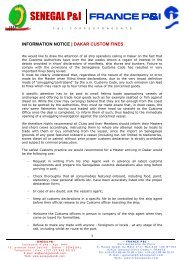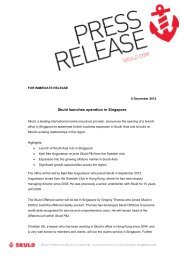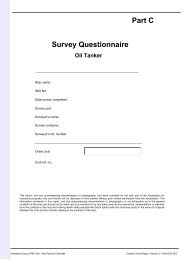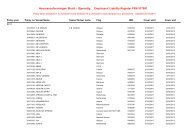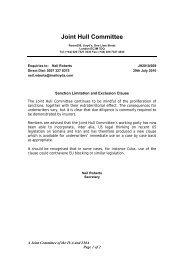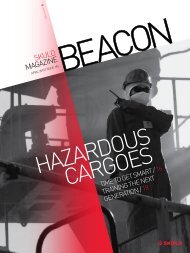Complete PDF version - Skuld
Complete PDF version - Skuld
Complete PDF version - Skuld
- No tags were found...
Create successful ePaper yourself
Turn your PDF publications into a flip-book with our unique Google optimized e-Paper software.
<strong>Skuld</strong>.com<strong>Skuld</strong>magazineJune 2009 / iSSue 194WhenPiRateS attackSome like it hot / 11the RotteRdam RuleS / 16
VieWPointDouglas Jacobsohnceo<strong>Skuld</strong>iS doing Wellearlier this year we concluded one of our most successful renewals inrecent times with a record growth in volume. in the current financialturmoil, our commitment to transparency is more important than everand helps our members and clients make decisions based on facts.beacon June 2009 / iSSue 194<strong>Skuld</strong>’s transparency and our financial model based on continuityin underwriting discipline pays. and delivering fast, personalisedprofessional and hands-on service for our business partners alsocertainly pays.Positioned for further growthWe continue to achieve a balanced underwriting result – premiumincome less claims and operating expenses – even in a period withincreasing claims inflation. this places <strong>Skuld</strong> in a strong competitiveposition and gives us the flexibility to expand business volume andmarket influence even further.our approach is yielding results. at the last renewals we achieved agrowth of 6 million gt. the club’s mutual members’ tonnage is nowabove 50 million gt and charterers’ tonnage over a further 40 million– a new record for <strong>Skuld</strong>. in addition, we have already seen a significantrecovery on our investment portfolio in the first quarter of 2009.Photo: ReuteRS/ScanPix Photo: © 1-imageS.nowhen PirAtes AttACKthis issue’s cover story features the hot topic of piracy and how <strong>Skuld</strong>works together with a range of organisations to ensure a constant flowof crucial information to our members.and, yes, some like it hot! lay-up changes P&i risk so you should takeyour cover into account when choosing to go ‘hot’ or ‘cold’. more onpages 11 to 13.We hope you enjoy this issue.douglaS JacobSohn<strong>Skuld</strong>magazinebeaconJune 2009 / iSSue 194Beacon (SkulD Magazine) is the official publication of assuranceforeningen <strong>Skuld</strong> (gjensidig)aDDreSS P.o. box 1376 Vika, no-0114 oslo, norway, tel +47 22 00 22 00, Fax +47 22 42 42 22e-Mail ingeborg.berge@skuld.com eDitor in chief ingeborg berge eDitorial Staff lise larsonlayout transmission aS repro anD printing 07 group front page Police escort a Somali piratefrom the French navy frigate Nivose after docking at the port of mombasa. Photo: Reuters/ScanpixBack page Wind turbines. entire contents ©2009, all rights reserved. Reproduction in whole or inpart, without written permission from <strong>Skuld</strong>, is prohibited. opinions expressed by writers in beaconare not necessarily those held by <strong>Skuld</strong>. <strong>Skuld</strong> assumes no responsibility for unsolicited materialWWW.<strong>Skuld</strong>.com11Some likeit hotit is crucial that ships are laid up technicallycorrect, so they can be successfully reactivatedwhen the world’s economy changes for the better.
contentSnewS feature4 When pirates attackloSS prevention11 Some like it hot14 mind your crew – a cautionary talelegal iSSueS16 the Rotterdam RulesnewS18 Personnel news19 news4When PiRateSattackWhere is it safest to navigate? how can youreduce the chance of a hijacking? What arethe insurance implications of an attack?<strong>Skuld</strong> proactively works with a wide rangeof organisations, including governmentaland inter-governmental bodies andinsurance groups, to ensure a constantflow of crucial information to our members.16theRotteRdamRuleSon 23 September 2009, the RotterdamRules are open for signatures. twentysignatures are enough to enter thesenew rules into force.
neWS FeatuReWhen PiRateS attackPhoto: ReuteRS/ScanPix
News featurewhen pirates attack/whenpiratesattackSo far in 2009, the total number of attacks worldwide isapproximately 130. Thirty-one vessels have been hijacked offthe Horn of Africa. Targets are becoming bigger and thearea of risk larger.
contributions byJonathan Hare Senior Vice President, Counsel, Maritime Law & International Group, <strong>Skuld</strong> OsloJørgen Rasch Vice President and Deputy Head of Syndicate, <strong>Skuld</strong> CopenhagenArild Wegener Director for Contingency Planning, Norwegian Shipowners’ AssociationWRITTEN BYBrad Larsonstrategically important Very LargeCrude Carrier (VLCC) traffic.“Currently there are some 40 orso naval vessels under multinationaland national commandsin ‘pirate areas’, most of them inthe GOA. All vessels under nationalcommand are tasked to the Gulfof Aden,” Arild points out. “Themultinational commands includethe European Union ATALANTAfleet and the standing NATOMaritime Group 1, part of whichcomes under Operation EnduringFreedom. Vessels from China,Russia, India, Saudi Arabia,Japan and other countries arealso active in the region, butunder national commands.”Although there are over 40 vesselsdeployed off the Horn of Africa,they are not all operationallyactive at any one time.ADJUSTING TACTICS“The significant military build-uphas made a difference,” Arildemphasises. “At least initially, asfar as geographical patterns areconcerned. Vessels deemedvulnerable are enjoying thebenefit of military protectionwhile in transit. There are alsomany instances of naval unitsand helicopters intervening inongoing attacks or those aboutto be launched.”However, this escalation in forcehas been unable to check therecent mushrooming of pirategroups and pirate communities.There are an increasing numberof newcomers and a vast area topatrol. In order to put a tight lid onpiracy over the enormous areain question, a massive navalbuild-up is required.One lesson can certainly belearned from the experience withthe military presence so far – theflexibility and ability to adjust tochanging pirate tactics is essential.PIRACY REFERENCE GROUPJust a ten-minute walk from theNorwegian Shipowners’Association, <strong>Skuld</strong>’s fourth floorhead office overlooks the oppositeside of Oslo Harbour. Here,Jonathan Hare is reviewing piracyupdates for the club’s website andother communication channels.Jonathan is <strong>Skuld</strong>’s Senior VicePresident and Counsel, responsiblefor Maritime Law and InternationalGroup activities – and a member ofthe <strong>Skuld</strong> Piracy Reference Group./ADVANCE PLANNINGThe majority of attacks fail. The chances of asuccessful hijacking are reduced throughcontingency planning and crew training. TheShip Security Plan required under the ISPSCode must include a section on piracy.Shipowners should also make sure that theirmasters and crews are properly prepared andsupported.There are two useful publications that greatlyassist in planning and training:• “Best Management Practices to DeterPiracy in the Gulf of Aden and off the Coastof Somalia”• “Piracy – The East Africa / Somalia Situation.Practical Measures to Avoid, Deter, andDelay Piracy Attacks in the Gulf of Aden andother Waters near the Horn of Africa –A Seafarer’s Guide”These can be downloaded free of charge fromwww.skuld.com (Piracy, Practical Guidance)French forces are actively involved inprotecting shipping.FEBRUARY 2009A kidnap and extortion consultancywarns that the highly favourable riskrewardratio in pirate attacks indicatesthat the situation will get worse beforeit gets better. A Greek-owned cargoship, the MV Saldanha, with a crew of22, is hijacked while sailing to Slovenia.Also in February, Somalian piratesrelease a Chinese fishing vessel, theUN anti-piracy group holds talks inLondon and naval forces appear toreduce attacks in the Gulf of Aden.Naval forces seem to reduce attacks inthe Gulf of Aden.MARCH 2009EU Navfor naval officials estimate thataround 90% of traffic entering the Gulffollows the protective corridorestablished by European Union navalforces. However, many vessels do notregister their voyage plans, limitingthe ability to identify specific risks andoffer help to the most vulnerablevessels. On 26 March, 16 to 18 pirateshijack the Norwegian tanker Bow Asir250 nautical miles off the Somaliancoast. The vessel is released in April.»beacon / june 20097
News featurewhen pirates attack“Our Piracy Reference Grouptakes advantage of the club’sglobal spread and the combinedexperience across its syndicates,”Jonathan notes.He and the other members of thePiracy Reference Group havebeen assuring a proactive flow ofinformation and important contactlinks on piracy for the past severalyears. They take advantage of<strong>Skuld</strong>’s website for providingaccess to up-to-date informationon this fast-changing issue –making <strong>Skuld</strong> one of the firstclubs to do so.“One of the questions that oftencomes up concerns the differencebetween piracy and terrorism,”observes Jonathan. “The motivationfor piracy is based on personal orcommercial rather than politicalgain. Although motivation maynot always be clear, the pirates inSomalia have been quite helpful.They point out that their motivesare purely non-political. However,the extreme turbulence in Somaliameans that this may change.”“Attacks in West Africa are mainlycriminally motivated, but sometimesgoals may at least in partbe political,” Jonathan notes.“This difference between piracyand terrorism can be importantin determining which insurancepolicy applies, and also inevaluating legality of a ransompayment.”Another question is whether ashipowner should enter into anagreement with a securitycompany. While it may be sensibleto seek advice from reputableand well-qualified consultants toprovide crew support and guidance,owners should be aware that theyare not covered for liabilitiesarising under contractualindemnities, unless such agreementsare approved in advance.HIRING GUARDS“The hiring of guards shouldsupplement, but not replace,proper crew training and contingencyplanning,” Jonathan says.“If guards are put on board, theremust be careful planning to makesure both the guards and creware briefed thoroughly so that allunderstand their respective duties.Otherwise misunderstandings caneasily arise that have extremelyunfortunate consequences.Ultimate responsibility for thenavigation and safety of the shiprests with the master. And anydilution of the master’s authoritymay amount to a breach of SOLASand other legal obligations.”“The question of armed guardshas also been receiving morefocus lately. Entering into anagreement with a securitycompany that provides armedguards is an operational decisionfor owners,” adds Jonathan.“Most governments and shippingorganisations advise against theuse of armed guards, largely onthe grounds that it leads to amore violent response by pirates.”In addition, the use of armedguards may cause legal difficulties.Consequently, the ship’s flagstate should always be consulted.There may be no insurance coverfor indemnities in contracts withsuch companies. In addition,liabilities arising from the use of‘weapons of war’ are excluded fromP&I cover, so insurers need to benotified. It is probably also wise toconsult with other interestedparties, such as charterers, cargointerests and war risk underwriters,in addition to ensuring the crewis aware of what is happening.“Attacks inWest Africaare mainlycriminallymotivated”month bymonthPIRACYThe Norwegian tanker Bow Asir isreleased in April.April 2009Pirates capture a French yacht in earlyApril. French forces storm the yachtwhen pirates refuse to free the hostages.One hostage is killed and the fourothers freed. Then, the Danish-ownedMaersk Alabama is captured bypirates and 21 American crew takenhostage, but are later able to retakethe ship. The pirates still hold thecaptain captive, but United StatesNavy SEALs and US Marine Corpssnipers kill three pirates during thesuccessful rescue operation.Twenty-one American crew are takenhostage during the hijacking of theMaersk Alabama.MAY 2009In mid-May, the US Coast Guard issuesa new maritime security directive,following the piracy attacks on theUS-flag vessels Maersk Alabama andLiberty Sun off the coast of Somalia.US-flag ships will now be required topost security guards on board if theyare transiting the Horn of Africa.Companies will be required to submitamended vessel security plans, but itis up to shipowners to decide whetherthese teams are armed.8 beacon / june 2009
News featurewhen pirates attack//INSURANCE QUESTIONS/ Does my owners’ P&I policy cover piracy?Although P&I cover excludes war risks, the definitionof ‘war risks’ does not include piracy (see <strong>Skuld</strong>’sRules Appendix 1). This means that P&I risks, such ascrew claims, cargo damage and pollution, are notexcluded on the grounds that they are caused by actsof piracy. The war risks exclusion does exclude liabilitiesarising from the use of ‘weapons of war’, but thegeneral view is that something more than guns or riflesis required before this part of the exclusion applies.Some owners have piracy included in their war riskscover, however. For example, the Norwegian MarineInsurance Plan includes piracy as a war risk. Memberswho have insurance cover on Norwegian terms aretherefore covered for piracy by their war risks insuranceprovider rather than their P&I club. Japanese warrisks cover also includes piracy./ Does my charterers’ policy include piracy?<strong>Skuld</strong>’s combined P&I and CLH cover contains thesame definition of war risks as owners’ policies do.Cover is therefore not excluded for claims arisingfrom pirate attacks.A French hostage was killed and four others freed when French forces launched amission to save hostages held on a luxury yacht off Somalia.PIRACY RISK“At any one time, there are usuallybetween ten and twenty vesselsheld in the vicinity of Somalia,”Jonathan notes. “About 22,000vessels transit the Gulf of Adenannually. Statistically the chancesof being hijacked are very low,but of course this is not muchconsolation for crew who arevery much in the front line. Theprobability that a hijack is carriedto completion depends on vesseldesign, crew training, weather,location and many other factors.”The common practice is for vesselsto be returned. After a negotiationperiod of between one and threemonths – and the payment of aransom – owners normally gettheir vessel and cargo backundamaged.“We are sometimes asked if it islegal to pay a ransom,” Jonathannotes. “This of course dependson the applicable national law.The payment is more likely to beillegal if terrorists are involved orthey are likely to benefit financially.”The Maritime Security Centre(Horn of Africa) – MSCHOA –advises vessels to maintain adistance of more than 600 nauticalPhoto: Reuters/Scanpix/ Will vessel loss or damage be covered under myhull or war risks policy?This depends on the terms of cover. Under theNorwegian Marine Insurance Plan (§ 2.9), piracy fallsunder war risks cover. In contrast, from 1983 theLondon market generally covered piracy under hullpolicy but, since 2005, alternative wordings are availablethat transfer piracy to war risks policy (InternationalHull Clauses 2002/3). The Swedish Hull Club’sinsurance conditions have recently been amended toexclude piracy. This is part of an increasing trendtowards regarding piracy as a war risk./ Is additional insurance available?Special Kidnap & Ransom (Extortion) cover is availableon the market and includes the service of consultantswho are able to provide support should the vessel beseized. Loss of earnings cover is at present available,normally for 30 days in excess of a seven-day deductible.Additional costs cover may be available on the market.We recommend you to contact your insurance broker,your <strong>Skuld</strong> underwriter or the special risks division of<strong>Skuld</strong> for guidance./ I am considering entering into an agreement with aprivate security company. Will my P&I cover includemy liabilities under this agreement?Contractual indemnities are not covered unlessapproved in advance and you must therefore contactyour <strong>Skuld</strong> underwriter. Exclusions may apply forclaims arising from use of weapons.beacon / june 2009 9
News featurewhen pirates attack/UP-TO-DATE INFORMATIONCurrent information is available from these websites:• Maritime Security Centre Horn of Africa (MSCHOA)www.mschoa.euSUDANERITREAKENYAETHIOPIAYEMENSOMALIA• International Maritime Bureau www.icc-ccs.orgSEYCHELLESShipowners are also strongly urged to ensure that before theirships transit the Gulf of Aden or coast of Somalia they:• Register on the MSCHOA website www.mschoa.eu or bye-mail to opscentre@mschoa.org• Join the Voluntary Reporting Scheme administered by UKMaritime Trade Operations by contacting UKMTO Dubai one-mail ukmtodubai@eim.ae or telephone +97 1505 523 215“We simplysupport ourmembers intheir carefor thecrews”miles from the coast and, whennavigating in the region, to operateat a heightened state of readiness.This means maintaining strict24-hour anti-piracy visual andradar watches, and activelyimplementing other recommendedanti-piracy measures.CREW SUPPORT“Through our experience with arange of piracy cases we havebecome aware of a number ofimportant steps to take regardingwelfare of the crew and theirrelatives,” emphasises JørgenRasch, <strong>Skuld</strong> Vice President andDeputy Head of Syndicate in<strong>Skuld</strong> Copenhagen. Jørgen isanother experienced member ofthe <strong>Skuld</strong> Piracy Reference Group.“From the time a member ship ishijacked, we recommend ourmembers take immediatecontact with the crew members’families, either directly or via thecrew manager, to give them aTANZANIAHigh-risk area off the Somali coast.status report and some idea ofthe normal course of events – thefact, for example, that crews,vessels and cargoes are mostoften returned unharmed after oneto three months,” Jørgen adds.“By passing on the experience wehave gathered, we assist ourmembers in their efforts to keepfamilies informed through, forinstance, meetings or a dedicatedweb page. We emphasise theneed to follow up on the mentalstate of the crew, not just afterthey are released, but also afterthey have arrived home. Assuringpost-incident care is an importantpart of our service,” he observes.“We simply support our membersin their care for the crews,” notesJørgen. “Often we’re behind thescenes and help in what ever waywe can. That’s part of ourcommitment to caring for ourmembers during a complex andchallenging time.”Jørgen also refers to the manyenquiries from membersregarding charterparty terms.Both INTERTANKO and BIMCOhave recently issued clauses andthere are also other clauses incirculation drafted by individualowners. Our advice is beingsought by both owners andcharterers and it is often necessaryto amend clauses to reflect theneeds of the individual member.A common question is whetherowners are obliged to followcharterers’ orders to proceedthrough the GOA or waters off theHorn of Africa. Owners understandablywant a firm yes or noanswer, but there is no alternativeother than studying each caseindividually and providing atailored response. It depends onfactors such as the vessel’sdesign and vulnerability to attack(freeboard, speed, etc.), and,above all, the charterparty terms.So, whether it’s providing currentinformation on the status ofhijackings in the Gulf of Aden,facilitating important links torelevant organisations, or givinginsight into the complexities ofinsurance cover and servicesupport, members value thesupport they receive from <strong>Skuld</strong>’sexperts on proactive piracyplanning. “When pirates attack,it’s nice to know there areexperienced people here to help,”Jørgen concludes.read morewww.skuld.com (Publications, Piracy)10 beacon / june 2009
LossPreventionBy Yvonne ThaulowUnderwriting Executive, <strong>Skuld</strong> Osloyvonne.thaulow@skuld.com/How lay-up changes P&I riskSome like it hotIt is crucial that ships are laid up technically correct, so they can be successfullyreactivated when they resume trading in a more favourable economic climate.The global slowdown in trade is causing an oversupply of vesselsresulting in an increasing number lying idle. Shipowners are adjustingby cutting costs. Newbuilds are being cancelled and existing vesselsare being sold, scrapped, recycled or laid up. Of those newbuildsreaching completion an increasing number are heading straight fromthe yard into lay-up rather than being traded at low rates.How long is lay-up?It is important to make a distinction between so-called hot lay-up andcold lay-up as these are totally different risks from a P&I perspective.The most important question for a shipowner to ask when decidingwhether to choose hot or cold lay-up is how long the vessel is estimatedto be in lay-up. The cost differential relating to these two options issignificant, with cold lay-up operational costs considerably lower thanthose for hot lay-up.Hot lay-up for quick reactivationIn hot lay-up, the vessel is normally deactivated for a limited numberof weeks. In this situation, the vessel has crew on board, the machineryis running and she can lift anchor when her owners/managers wish todo so. Hence, she can be ready for quick reactivation. Many shipownerschoose hot lay-up while they assess market conditions. <strong>Skuld</strong> treatshot lay-up situations as trading and, therefore, no return of premium isnormally granted.Cold lay-up for cost reductionIn cold lay-up, machinery is taken out of service and the vessel is keptelectrically dead, except for emergency power. Apart from watchmenthe vessel is unmanned. Furthermore, there is no cargo on board.Effective reactivation can take anything from a few weeks to severalmonths, depending on the time spent in lay-up and the level ofpreservation and maintenance undertaken. Cold lay-up results insignificant cost reduction for shipowners. However, cold lay-upprovides low flexibility (compared to hot lay-up) when the long timerequired for reactivation is considered.<strong>Skuld</strong> focuses on cold lay-up as it implies an alteration of risk for theclub. When advised of a vessel in cold lay-up, information isrequested to complete an overall risk assessment. In order to assesswhether or not a vessel is successfully laid up, a lay-up declarationfrom a classification society, or other organisation approved by <strong>Skuld</strong>,is required.Lay-up site carefully chosenIt is essential that the lay-up siteis carefully chosen. Some keyconsiderations include: shelterfrom heavy wind, current andswell, seabed characteristics thatprovide adequate anchor holdingpower and distance to other ships.Also, it is vital to coordinate thelay-up process with the nationaland local authorities, whichpermit vessels to be anchored/moored off their coast. Theenvironmental conditions at thelay-up site are also very importantwhen deciding what preservativemeasures are taken. For instance,if the vessel is laid up at a siteexposed to sub-zero temperaturesthen damage from freezing needsto be prevented.A major challenge for ships inlay-up is humidity. The longer avessel is laid up, the moreHot lay-up means quick reactivation.The vessel can swiftly lift anchor andresume trading. Insurance premiumsremain the same.“<strong>Skuld</strong>focuseson coldlay-up as itimplies analterationof risk forthe club”beacon / june 2009 11
loSS/PReVentionthe lay-up site should be carefully chosen. here, on theriver Fal in cornwall, england, the harbour master is keptbusy with increasing demand for berths.Photo: © 1-imageS.nobeacon / June 200913
LosspreventionEnsure your crew’s welfareMembers must consider boththeir crew’s physical andmental well-being.Mind your crew– a cautionary taleDuring a routine voyage last year a crew man was lost overboard froma member’s vessel. A tragic event, made even more tragic because itcould, perhaps, have been prevented.During the night a member ofthe crew contacted the master tosay he felt threatened by anothercrew man, who he didn’t identify,and was worried about his ownsafety. The call came in fairlylate and the master told thecrew man to go to sleep and thatthey would talk in the morning.Unfortunately, by that time, itwas too late.As part of an investigationundertaken by <strong>Skuld</strong>, the eventsof the night in question werereconstructed. Shortly aftercontacting the master, the crewmember left his cabin andproceeded to take several itemsof ship’s equipment for survivalat sea, including a life jacket and14 beacon / june 2009
By Christian OttAssistant Vice President, <strong>Skuld</strong> Far Eastchristian.ott@skuld.comLossprevention/an immersion suit. Weatherconditions were rough. It wasclear he was desperate to leavethe ship as he apparently tried tolaunch two life rafts. During thisoperation, or in the process oftrying to get on to one of them,he fell into the water anddrowned. His body wasrecovered later by fishermen.Not the first signWhat would drive a man, someonewho was no stranger to lifeat sea, to take such a great riskby trying to leave the ship atnight when it was under way incircumstances where the smallestmistake could cost him his life?The investigation revealed thatthe phone call on that fatefulnight was not the first sign oftrouble. Subsequent interviewswith the master and the crewdisclosed that the crew man didfeel threatened by someone, butfor reasons unknown, and thathe had previously wanted toleave the ship and sign off. Inaddition, a close family memberhad become seriously ill not longbefore this event, and a requestfor compassionate leave hadbeen refused. The crew man’sbehaviour had become moreerratic in the days leading upto the tragedy.Misadventures of this nature orsuicides always result in difficultsituations for members, asfamilies rarely like to admit thata loved one made such a tragicdecision. In addition, the loss ofa breadwinner is a serious blowand can place a family into realdifficulty, especially in thecurrent economic climate. In alllikelihood, a significant claim fordeath compensation may follow,to which a member may alsohave to add investigative expensesand costs relating to recovery/and repatriation of the remains.A criminal investigation may alsofollow.Technically and legally speaking,a member will not normally beliable for death or injury resultingfrom suicide or another wilfulact of self harm.Yet, as it can be difficult tosuccessfully prove that mitigatingcircumstances exist, such casesoften end in a situation whereit’s impossible to firmly concludewhether a death resulted from adeliberate act or just mis adventure.Employment tribunals and courtsmay, understandably, also bevery sympathetic to a grievingfamily facing a difficult time.Ensure the crew’s welfareThe key lesson from this story isthat members need to maintainclear focus on ensuring crewwelfare, not just in terms ofphysical health, but also theirmental well-being. Seafaring isstressful and demanding, andcrews face ever increasingUnderstand the danger signschallenges from coping with theamount of work a modern shipcreates, the never-endingincrease in regulatory requirements,as well as the risks ofaccidents, piracy and thecriminalisation of seafarers. Addto this the general stress that aharsh economic climate brings,and some people are pushed tothe edge and beyond.A happy crew is a safe crewA well-managed ship with analert master and officers,attuned to the crew and theirneeds, is one of the very bestloss prevention measures possible.A happy crew is a safe crew andvital for the sound operation ofthe ship./ <strong>Skuld</strong> can give you detailed advice on loss prevention and crewwelfare, but it is worth keeping in mind that the following aresigns of a potentially critical problem that the master shouldact on immediately:- Crew member becoming distant from other crew or spendingtoo much time alone- Failure to show up for work on time- Failure to join in group events, especially sharing of meals- Sudden inexplicable changes in performance and/or attitude- Unprovoked, threatening, erratic, or paranoid behaviourtowards other crew- Repeatedly serious arguments between crew- Signs of serious stress or depression- Significant negative events in a crew member’s personalcircumstances and/or those of their family“A happycrew is asafe crewand vital forthe soundoperation ofthe ship”beacon / june 2009 15
LEGALISSUESSeachange for international tradeTHE ROTTERDAM RULESOn 23 September 2009, the Rotterdam Rules are open for signatures.Twenty signatures are enough to enter these new rules into force.On 11 December 2008, by Resolution No. 122 at the sixty-third session,the General Assembly of the United Nations adopted the ‘Conventionon Contracts for the International Carriage of Goods Wholly or Partly bySea’ (hereafter the Rotterdam Rules). These were the cumulation ofmore than a decade of work by CMI (Comité Maritime International)and UNCITRAL (United Nations Commission on International TradeLaw). The purpose is to create a modern and uniform law thatharmonises international marine contract law on liability for carriageof goods by sea.Today, we are familiar with the Hague, the Hague-Visby and theHamburg Rules 1 , which are wholly or partly adopted by various statesinvolved in international trade 2 . Since 1924 the dominant set has been,and still is, the Hague Rules, which were overhauled to some extent in1968 and replaced by the Hague-Visby Rules. These rules (Hague andHague-Visby) have received much criticism for being too shipownerfriendlyand out of date, especially in relation to navigation andcommunication.Main changesThe Rotterdam Rules are 18 chapters/96 articles of complex reading.They significantly change the Hague and Hague-Visby Rules in thefollowing ways:• Continuing obligation for keeping a vessel seaworthy,including due diligence throughout the sea carriage• The nautical fault exclusion no longer an available defence• Loss, etc. by fire caused by crew negligence no longer availableas a defence• Liability for economic loss resulting from delay beyond the agreeddelivery time• Increased package and weight limitation• Applies door-to-door. Not relevant, however, for owners andcharterers uninvolved in pre/post sea-carriage• A holder (controlling party) of a bill of lading or similar document may,during the carriage, re-direct a ship to another discharge port ororder the cargo to be discharged for another partyThere are two revolutionary changes that these rules introduce. Firstly,a shipowner needs to keep their vessel seaworthy (per definition)throughout the entire sea-carriage. Secondly, the owner is now liablefor losses, etc. from fire or navigation errors if the crew has beennegligent. For centuries, these defences have given a clear and coherentsystem of assessing risks forinsurers of both ships andcargoes. Now, theoretically, if theRotterdam Rules are endorsed, it isnatural that insurance premiums/deductibles for cargo risks (P&I)for shipowners and charterersincrease, and the premiums/deductibles for traders’ cargoinsurance decrease. From apractical point of view it is,however, difficult to say whateffects the new rules will have ofcourse. Only time will tell.It comes as no surprise that thesuggested Rotterdam Rules havealready come under criticism.Professor William Tetley of McGillLaw Faculty 3 says the following:“The final drafting was apparentlynot by a single drafter, but by a verylarge committee with manycommentators. A single drafterprovides a simpler and morecoherent product.’ (…) ‘The RotterdamRules are very long. Will they beintelligible or understandable toeven the skilled ship operator orowner or charterer or shipper orconsignee or receiver, etc? Willeven the skilled full-time maritimelawyer not have constant, importantdoubts as to their meaning?’ (…)‘The Rotterdam [R]ules are not acarriage act or a multimodal actbut a contracts act. This is a verynew and unfamiliar approach.’ ( …)‘In general the Rotterdam Rulesare in content terms, style anddrafting in an unfamiliar form. Thisnot only erases years of practice“TheRotterdamRules are 18chapters/96 articlesof complexreading”16 beacon / june 2009
By Marcus LindforsClaims Executive, <strong>Skuld</strong> Oslomarcus.lindfors@skuld.comLegalissues/xxThe new rules will cause a seachange for international trade. They are open for signatures in Rotterdam from 23 September this year.and custom, but sets aside 100years of established jurisprudence.”To the rules’ defence, it should besaid that the aim is admirable, i.e.that one set of rules prevails forcargo liability no matter whatcountry’s waters a vessel sails in.With the following prefatorywords the General Assembly forthe Rotterdam Rules states thatit is:‘Concerned that the current legalregime governing the internationalcarriage of goods by sea lacksuniformity and fails to adequatelytake into account modern transportpractices, including containerization,door-to-door transport contractsand the use of electronic transportdocuments.’ (…) and (…) ‘Convincedthat the adoption of uniform rulesto modernize and harmonize therules that govern the internationalcarriage of goods involving a sealeg would enhance legal certainty,improve efficiency and commercialpredictability in the internationalcarriage of goods and reduce legalobstacles to the flow of internationaltrade among all States.’It is not the first time that stepsare being taken to try and changewell-established principles forcarriage of goods by sea. A goodexample concerns the ancientconcept of general and particularaverage and the suggested York-Antwerp Rules of 2004, where therisks of a common venture,previously shared between cargoand ship, now to a much largerextent have been pushed over tothe shipowner.After 23 September, we’ll knowwhether the rules will gain thenumber of signatures requiredfor ratification. It is, however,already clear that some influentialcountries, including the UnitedStates and Japan, are in favour ofthe rules. The European Union,China and India are also expectedto add their consent, so it is mostlikely that carriers and traders ofthe world will soon face a new‘chapter’ in the exciting life ofinternational trade.The International Group of P&IClubs, including <strong>Skuld</strong>, has notyet taken a position on theRotterdam Rules.1) The Hamburg Rules of 1978 did notcome into force until 1992 and did notprovide the effect that was hoped for.2) The maritime codes of the Scandinaviancountries blend the’ flavours’ of theHague-Visby and Hamburg Rules andprovide an example of the hybridapproach.3) Summary of Some General Criticismsof the UNCITRAL Convention (The RotterdamRules) – Preliminary observations ofWilliam Tetley, Nov. 5, 2008 - http://www.mcgill.ca/maritimelaw/rotterdamrules/.read morehttp://www.uncitral.org/uncitral/en/index.htmlbeacon / june 2009 17
personnelnewsnew employees & Promotions/Changes1357246/ Gender split of<strong>Skuld</strong> staff:51/49Women/menSKULDHAMBURG1 / Thomas Bjørn LarsenSenior Vice PresidentHead of OfficeThomas Bjørn Larsen (47) takesover as Senior Vice President,Head of <strong>Skuld</strong> Hamburg from1 July. Thomas has been with<strong>Skuld</strong> Copenhagen since 1991,with the exception of a secondmentto <strong>Skuld</strong> Hong Kong in1999. He was a <strong>Skuld</strong> boardmember from 2000 for eightyears. In 2008, he was namedAssistant Vice President andjoined <strong>Skuld</strong> Germany in March2009. Before joining <strong>Skuld</strong>,Thomas Bjørn Larsen studiedlaw at the Universities ofCopenhagen, Oslo and UCL, andworked for Danish shipownersA.P.Møller-Maersk. He teachesmaritime law at the Universityof Copenhagen and othervenues and is now finalising hisMA in Marine Insurance & RiskManagement at the Universityof Oslo.SKULDOSLO2 / Jens BergrahmSenior Vice PresidentAsset ManagementJens Bergrahm (46) is appointedSenior Vice President AssetManagement. Jens has morethan 20 years’ experience of riskmanagement and trading, bondand equity portfolio management,tactical asset allocationand proprietary trading, andhedging of financial marketexposure. Jens has a Bachelorof Science in Business (Finance)and a Master of BusinessAdministration from MurrayState University, USA and hasheld various positions withinSEB Skandinaviska EnskildaBank and SKF AB TreasuryCentre. He comes to <strong>Skuld</strong> froma position as Portfolio ManagerGlobal Team at Andra AP-fonden.3 / Elisabeth BullSenior Executive Credit ControlElisabeth Bull (40) is appointedSenior Executive in the CreditControl department. Elisabethstarted in <strong>Skuld</strong> as an Accountantin 1990 and has been a CreditController since 1998. She hasstudied Economics at theNorwegian School ofManagement (BI). Her newresponsibilities includecoordination of futuredevelopment projects and creditcontrol support.4 / Johan GjernesSenior Vice PresidentUnderwriting Risk ManagementJohan Gjernes (37) is appointedSenior Vice President UnderwritingRisk Management.Johan joined <strong>Skuld</strong> Oslo in 1998as Claims Executive andtransferred to Underwriting in2000. Since 2005, he has servedas Head of <strong>Skuld</strong> Hellas. Johanhas seagoing experience as aDeck Officer. He has studiedmaritime engineering, nauticalengineering and maritime law,and has an MBA from theNorwegian School of Economicsand Business Administration(NHH).5 / Lisbeth LarsenReceptionistLisbeth Larsen (57) is appointedReceptionist in <strong>Skuld</strong> Oslo.Previously, Lisbeth worked forFPS Ocean, an offshore/oil rigcompany, where she worked asreceptionist. She has relevantexperience from severalcompanies and has also livedabroad for a number of years.SKULDPIRAEUS6 / Clas RydénSenior Vice PresidentHead of OfficeClas Rydén (48) is appointedSenior Vice President and Headof <strong>Skuld</strong> Hellas. Clas comesfrom a position as Head of theSwedish Club in Piraeus. He hasstudied mechanical engineeringand naval architecture atChalmers University of Technologyin Gothenburg and joined theSwedish Club in 1987, where heserved first in the technicaldepartment and later as TechnicalManager in Hong Kong. Since1993 – with the exception of athree-year period with the headoffice’s underwriting andmarketing team – Clas has beenGeneral Manager of the SwedishClub’s Piraeus office.7 / Mattias HedquistAssistant Vice PresidentMattias Hedquist (36) is promotedto Assistant Vice President,Claims. Mattias joined <strong>Skuld</strong> in2002 as Claims Executive in<strong>Skuld</strong> Oslo. In 2006, he transferredto <strong>Skuld</strong> Piraeus and wasnamed Senior Executive, Lawyerin 2008. He has an LLB, LLMfrom Lund University and anLLM from the University of Oslo.18 beacon / march 2009 beacon / december 2008 18
neWSSoMe current caSeS anD other SkulD newS/ SeriouS inJurya crew member suffered seriouscuts while performing on-boardmaintenance work. Surgery andlengthy hospitalisation wasnecessary. <strong>Skuld</strong> bergen followedup closely by supporting the crewmember and shipowner, includingtaking measures to monitor andcontain medical costs./ Brain inJury in alaBaMaa shore-side worker suffered abrain injury after he fell inside thehold while working on a vessel ina drydocking yard in alabama.after the injured worker filed amulti-million dollar suit againstthe vessel owner and the yard,the owner commenced limitationof liability proceedings. thelitigation is in its early stages./ SucceSSful Defence ofaSSignMent<strong>Skuld</strong> charterer members settledseveral open positions with anowner through a commercialsettlement that included anassignment of hires under acharterparty with sub-charterers.the sub-charterers sought tochallenge the validity of theassignment and repudiate thewhole contract on the basis of aninvalid assignment. <strong>Skuld</strong> success -factSclaims incurred for own accountuSd mill14413786049505121060708Source: SkulD claiMS hanDlingfully supported the member incooperating with owners. theresult was a sweeping high courtvictory, which included cost orders./ valuaBle cargo loSta valuable piece of cargo was lostoverboard during extreme weatherconditions. experts were appointedto investigate how the cargo wassecured and the vessel’s condition,as well as taking detailed statementsfrom the crew, establishingdefence and gaining knowledgefor loss prevention purposes./ future contaMinationpreventeDat discharge, a cargo of causticsoda carried on a danish vesselshowed hydraulic oil contamination.the post discharge surveyconcluded that the vessel was notat fault. meticulous investigationin a similar case some weekslater, however, uncovered a defectcargo tank pump seal, and consequentlyliability in the case of thedanish vessel. looking on thepositive side, future cargocontamination was prevented.SkulD School 2009this year’s <strong>Skuld</strong> School will beheld from 7-9 october in oslo.the certificate given by theschool is primarily aimed atmembers’ junior staff or others inshipping that need to know thebasics of P&i insurance.heBei two releaSeDorganisations from across theworld’s shipping industry haveissued a vigorous joint protest atthe unjust and unreasonabledetention of the captain and chiefofficer of the Hebei Spirit. on 11June, we received the great newsthat they were finally free to leaveSouth korea and return to india.reaD MoreSee Beacon December 2008neW book FoRmembeRS/caPtainS legalthrough its cooperation with publishers Witherby Seamanshipinternational ltd., <strong>Skuld</strong> now offers a separate edition of ‘captainslegal’ to all its members.While sailing around the world a captain encounters various rules andregulations, some of which he is familiar with and others, particularlycountry-specific ones, less so. maritime law, on the other hand, isdesigned for international use regardless of flag or administration.many problems arise because one side or other does not understandthe applicable law for a given incident. and it is serious if shoreauthorities come to believe that ships’ masters are unfamiliar withthe laws and regulations they are supposed to uphold.there are a number of books dealing with all aspects of maritime lawand business. however, the aim of ‘captains legal’ is to explain – inplain language – the laws governing incidents and problems that amaster might encounter on an average vessel, of any registration,while sailing the world’s oceans.“it is the sort of book that should be left lying around the bridge foreveryone to have a look at”, says captain nick cooper.every <strong>Skuld</strong> member receives a copy of the book free of charge. Furthercopies may be ordered directly from www.witherbyseamanship.com/category/<strong>Skuld</strong>.htm. by entering the promotional code <strong>Skuld</strong>SPec,<strong>Skuld</strong> members receive 20% discount on the retail price of gbP 25.reaD Morewww.skuld.com (publications)beacon / June 2009 19
<strong>Skuld</strong>magazinenext iSSueout noveMBer 2009WindSoF changethe offshore industry is changing. windfarms and other forms of alternative energyare gaining ground. how can <strong>Skuld</strong>, as aninsurer, respond to future industry demands?and what progress has been made by <strong>Skuld</strong>’srecently established offshore syndicate?in our november issue we will take acloser look at these developments, includingcoverage of some of our offshore members’operations.aBout SkulDas the new generation P&i club,SkulD provides liability insuranceto new generation shipowners andclients in the shipping industry.the head office for our globaloperations is located in oslo,with additional offices in bergen,copenhagen, hamburg, hong kong,moscow, new york and Piraeus.24-houRemeRgencynumbeR+47 952 92 200call this number if you havean emergency incident where<strong>Skuld</strong> can assist.Beacon Back iSSueSFor back issues of beacon, please go to the publicationssection of our website. you can print an entire issue oruse the table of contents to select individual articles.earlier eDitionSwww.skuld.com(publications: Beacon)RuSelØkkVeien 26no-0251 oSloP.o. box 1376 Vikano-0114 oSlonoRWaytel +47 22 00 22 00Fax +47 22 42 42 22<strong>Skuld</strong>.com



